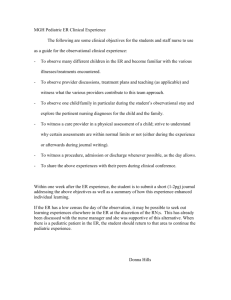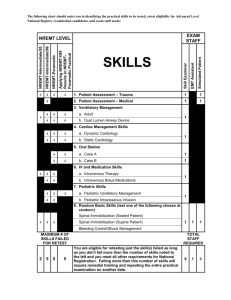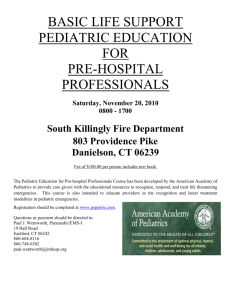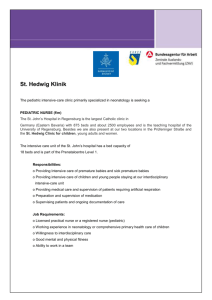Plan Nursing
advertisement
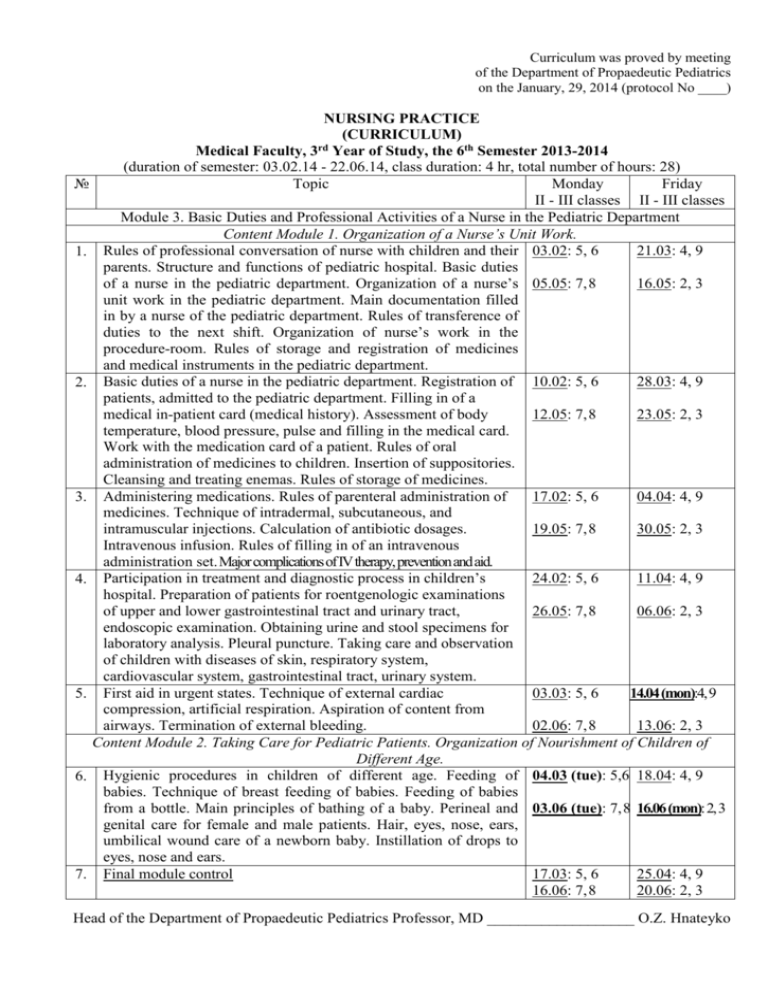
Curriculum was proved by meeting of the Department of Propaedeutic Pediatrics on the January, 29, 2014 (protocol No ____) NURSING PRACTICE (CURRICULUM) Medical Faculty, 3rd Year of Study, the 6th Semester 2013-2014 (duration of semester: 03.02.14 - 22.06.14, class duration: 4 hr, total number of hours: 28) № Тopic Monday Friday ІІ - ІІІ classes ІІ - ІІІ classes Module 3. Basic Duties and Professional Activities of a Nurse in the Pediatric Department Content Module 1. Organization of a Nurse’s Unit Work. 21.03: 4, 9 1. Rules of professional conversation of nurse with children and their 03.02: 5, 6 parents. Structure and functions of pediatric hospital. Basic duties of a nurse in the pediatric department. Organization of a nurse’s 05.05: 7, 8 16.05: 2, 3 unit work in the pediatric department. Main documentation filled in by a nurse of the pediatric department. Rules of transference of duties to the next shift. Organization of nurse’s work in the procedure-room. Rules of storage and registration of medicines and medical instruments in the pediatric department. 28.03: 4, 9 2. Basic duties of a nurse in the pediatric department. Registration of 10.02: 5, 6 patients, admitted to the pediatric department. Filling in of a medical in-patient card (medical history). Assessment of body 12.05: 7, 8 23.05: 2, 3 temperature, blood pressure, pulse and filling in the medical card. Work with the medication card of a patient. Rules of oral administration of medicines to children. Insertion of suppositories. Cleansing and treating enemas. Rules of storage of medicines. 17.02: 5, 6 04.04: 4, 9 3. Administering medications. Rules of parenteral administration of medicines. Technique of intradermal, subcutaneous, and intramuscular injections. Calculation of antibiotic dosages. 19.05: 7, 8 30.05: 2, 3 Intravenous infusion. Rules of filling in of an intravenous administration set. Major complications of IV therapy, prevention and aid. 24.02: 5, 6 11.04: 4, 9 4. Participation in treatment and diagnostic process in children’s hospital. Preparation of patients for roentgenologic examinations of upper and lower gastrointestinal tract and urinary tract, 26.05: 7, 8 06.06: 2, 3 endoscopic examination. Obtaining urine and stool specimens for laboratory analysis. Pleural puncture. Taking care and observation of children with diseases of skin, respiratory system, cardiovascular system, gastrointestinal tract, urinary system. 03.03: 5, 6 14.04 (mon):4, 9 5. First aid in urgent states. Technique of external cardiac compression, artificial respiration. Aspiration of content from airways. Termination of external bleeding. 02.06: 7, 8 13.06: 2, 3 Content Module 2. Taking Care for Pediatric Patients. Organization of Nourishment of Children of Different Age. 6. Hygienic procedures in children of different age. Feeding of 04.03 (tue): 5,6 18.04: 4, 9 babies. Technique of breast feeding of babies. Feeding of babies from a bottle. Main principles of bathing of a baby. Perineal and 03.06 (tue): 7, 8 16.06 (mon): 2, 3 genital care for female and male patients. Hair, eyes, nose, ears, umbilical wound care of a newborn baby. Instillation of drops to eyes, nose and ears. 7. Final module control 17.03: 5, 6 25.04: 4, 9 16.06: 7, 8 20.06: 2, 3 Head of the Department of Propaedeutic Pediatrics Professor, MD ___________________ O.Z. Hnateyko Curriculum was proved by meeting of the Department of Propaedeutic Pediatrics on the January, 29, 2014 (protocol No ____) NURSING PRACTICE Medical Faculty, 3rd Year of Study, the 6th Semester 2013-2014 Curriculum of Self-works № Тopic Hours Type of control Module 3. Basic Duties and Professional Activities of a Nurse in the Pediatric Department 1. Acquaintance with main law documents, 1 Final module control 4 During classes 1 Final module control Evening duty in pediatric department 2 During classes Evening duty in infant’s department 2 During classes Preparation to the final module control 2 Final module control Total 12 regulating nurse’s professional activity in pediatric department. 2. Independent practical training in pediatric department. 3. Filling in of daily and final report documents of nursing practice. 4. 5. Individual work Head of the Department of Propaedeutic Pediatrics Professor, MD __________________________ O.Z. Hnateyko Suggested Readings 1. Essential Competencies For Patient Care / ed. by Mary Elizabeth Milliken, BSN, MS, Ed. D., Gene Campbell, BSN, M.Ed. – The C. V. Mosby Company, St. Louis, Toronto, Princeton, 1985. – P. 685 – 2. Fundamentals of Nursing (Concepts and Procedures) / ed. by Barbara Kozier, BA, BSN, RN, MN; Glenora Erb, BSN, RN. – Addison – Wesley Publishing Company, Nursing Division, Menlo Park, California, 1983. – P. 13 –15, 21 – 32, 39 – 46, 49 – 51, 233 – 256, 414 – 416, 444 – 446, 451 – 465, 485, 491 – 529, 531 – 534, 935 – 938, 942 – 947, 952 – 981. NURSING PRACTICE Module 3: Basic Duties and Professional Activities of a Nurse in the Pediatric Department Theoretical Issues for the Final Module Control No 3 1. Basic deontological principles of conversation of the nurses with children and their relatives. 2. The main duties of a nurse in the pediatric department. 3. Organization of the nurse’s unit work in the pediatric department. Main documentation filled in by a nurse of the pediatric department. Rules of transference of duties to the next shift. 4. Organization of nurse’s work in the procedure-room. Rules of storage and registration of medicines and medical instruments in the pediatric department 5. Assessment of body temperature, blood pressure, pulse in pediatric practice. 6. Rules of oral administration of medicines to children. 7. Rules of storage of medicines 8. Rules of parenteral administration of medicines. 9. Technique of intradermal, subcutaneous, and intramuscular injections. 10. Calculation of antibiotic dosages. 11. Intravenous infusion. Rules of filling in of an intravenous administration set. Major complications of IV therapy, prevention and aid 12. Insertion of suppositories. Cleansing and treating enemas. 13. Peculiarities of compress applying, hot-/ice-bags applying in pediatric practice 12. Obtaining of urine for routine urinalysis, for Zimnitskiy’s test, Netchyporenko test, Addis test and their diagnostic value. 13. Guidelines for preparation of pediatric patients to the radiological studies of the gastrointestinal tract, urinary system, endoscopy of the gastrointestinal tract. 14. Principles of the first aid for the child with laryngospasm and spasmodic croup, foreign body in the airways, asthma attack, convulsive syndrome, acute vascular insufficiency (loss of consciousness, collapse). 15. The main signs of clinical death. Rules for initial cardiopulmonary resuscitation. 16. Principles of taking care and monitoring of patients with pathology of the skin. 17. Principles of taking care and monitoring of patients with respiratory disorders. 18. Principles of taking care and monitoring of patients with disorders of the cardiovascular system. 19. Principles of taking care and monitoring of patients with disorders of the gastrointestinal tract 20. Principles of taking care and monitoring of patients with pathology of the urinary system. 21. Principles of the hygienic bath for infants. Perineal and genital care for female and male patients. 22. Hair, eyes, nose, ears of pediatric patients 23. Instillation of drops to eyes, nose and ears. 24. Taking care of newborn. Umbilical wound care. 25. Technique of breast feeding of babies. 26. Feeding of babies from a bottle. Practical Skills for the Final Module Control No 3. 1. To demonstrate the ability to give medicine for internal use child of the certain age. 2. To demonstrate the technique of the subcutaneous injection. 3. To demonstrate the technique of the intramuscular injection. 4. To calculate the dose of antibiotic and dilute it if necessary. 5. To prepare the intravenous set for injection 6. To prepare necessary solutions for parenteral administration. 7. To measure body temperature of a sick child and note it in the observation list 8. To study the pulse of a sick child and measure blood pressure. 9. To study respiratory rate of a child. 10. To note respiratory rate, pulse rate, blood pressure in the observation list of the patient 11. To demonstrate the technique of swaddling of the infant. 12. To demonstrate the technique of bathing, perineal care for a sick child. 13. To demonstrate the technique of taking swabs from the nose and throat. 14. To demonstrate the technique otic, nasal, ophthalmic installations. 15. To prepare necessary equipment and demonstrate the technique of the gastric lavage 16. To prepare the necessary equipment for cleansing enema and demonstrate the technique of enema application. 17. To prepare the necessary equipment for therapeutic enema and demonstrate the technique of enema application 18. To demonstrate methods of oxygen therapy in paediatric practice. 19. To prepare necessary equipment and demonstrate the technique of hot compress applying on the ear of the child. 20. To prepare necessary equipment and demonstrate the technique of taking care of the mouth, nose, eyes, ears and umbilical wound of a newborn baby. 21. To prepare appropriate equipment and to demonstrate the technique of breast-/bottle-feeding of the infant. 22. To demonstrate the technique of resuscitation in paediatric practice.
